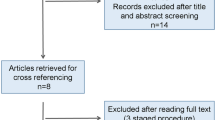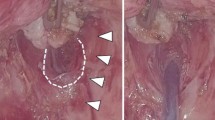Abstract
Purpose
Megarectum in anorectal malformation (ARM) causes severe morbidity. To compare conservative management (CM) of megarectum with excision (EX), to propose a new classification and to analyse management strategies.
Methods
Between 2000–2016, we reviewed all ARM to identify megarectum, defined by radiological recto-pelvic ratio > 0.61. A new classification was proposed: primary megarectum (PM) pre-anorectoplasty, and secondary megarectum (SM) post-anorectoplasty, with sub-types. Complications and Krickenbeck bowel function were compared between CM and EX.
Results
Of 124 ARM, 22 (18%) developed megarectum; of these, 7 underwent EX. There was no difference in functional outcomes when comparing CM vs EX—voluntary bowel movement (both 86%), soiling (40% vs. 57%) and constipation (both 86%). However, EX was associated with major complications (43%) and the requirement for invasive bowel management, compared to CM (85% vs. 27%, P = 0.02). 6/7 EX needed antegrade continence enema (ACE), one of these has a permanent ileostomy. With strategic changes, incidence of megarectum reduced from 20/77 (26%) to 2/47 (4%) after 2013 (P = 0.002).
Conclusion
EX did not confer benefit in the functional outcome but carried a high risk of complications, often needing ACE or stoma. By adhering to strategies discussed, we reduced the incidence of megarectum and have avoided EX since 2013.

Similar content being viewed by others
Abbreviations
- ACE:
-
Antegrade continence enema
- ARM:
-
Anorectal malformation
- ARP:
-
Ano-rectoplasty
- CM:
-
Conservative management
- EX:
-
Excision of megarectum
- FU:
-
Follow-up
- ISSA:
-
Internal sphincter-sparing ano-rectoplasty
- PM:
-
Primary megarectum
- PSARP:
-
Posterior sagittal ano-rectoplasty
- SCT:
-
Sacrococcygeal teratoma
- SM:
-
Secondary megarectum
- TAI:
-
Transanal irrigation
References
Borg H, Bachelard M, Sillén U (2014) Megarectosigmoid in children with anorectal malformations: long term outcome after surgical or conservative treatment. J Pediatr Surg 49:564–569. https://doi.org/10.1016/j.jpedsurg.2013.08.003
Cloutier R, Archambault H, D'Amours C, Levasseur L, Ouellet D (1987) Focal ectasia of the terminal bowel accompanying low anal deformities. J Pediatr Surg 22:758–760
Zia-ul-Miraj M, Brereton RJ (1997) Rectal ectasia associated with anorectal anomalies. J Pediatr Surg 32:621–623
Keramidas DC, Soutis M, Mavridis G, Papandreou E (2005) Rectosigmoid ectasia associated with anorectal anomaly repair: experience with sigmoid anterior resection and endorectal pull-through. Eur J Pediatr Surg 15:268–272. https://doi.org/10.1055/s-2005-865764
Peña A, el Behery M (1993) Megasigmoid: a source of pseudoincontinence in children with repaired anorectal malformations. J Pediatr Surg 28:199–203
Burjonrappa S, Youssef S, Lapierre S, Bensoussan A, Bouchard S (2010) Megarectum after surgery for anorectal malformations. J Pediatr Surg 45:762–768. https://doi.org/10.1016/j.jpedsurg.2009.10.043
Miyahara K, Kato Y, Seki T, Arakawa A, Lane GJ, Yamataka A (2009) Neuronal immaturity in normoganglionic colon from cases of Hirschsprung disease, anorectal malformation, and idiopathic constipation. J Pediatr Surg 44:2364–2368. https://doi.org/10.1016/j.jpedsurg.2009.07.066
Holbrook C, Misra D, Zaparackaite I, Cleeve S (2017) Post-operative strictures in anorectal malformation: trends over 15 years. Pediatr Surg Int 33:869–873. https://doi.org/10.1007/s00383-017-4111-6
Kyrklund K, Pakarinen MP, Rintala RJ (2017) Long-term bowel function, quality of life and sexual function in patients with anorectal malformations treated during the PSARP era. Semin Pediatr Surg 26:336–342. https://doi.org/10.1053/j.sempedsurg.2017.09.010
Levitt MA, Peña A (2005) Outcomes from the correction of anorectal malformations. Curr Opin Pediatr 17:394–401
Levitt MA, Peña A (2007) Anorectal malformations. Orphanet J Rare Dis 2(33):1–13. https://doi.org/10.1186/1750-1172-2-33
Keshtgar AS, Ward HC, Richards C, Clayden GS (2007) Outcome of excision of megarectum in children with anorectal malformation. J Pediatr Surg 42:227–233
Preston DM, Lennard-Jones JE, Thomas BM (1985) Towards a radiologic definition of idiopathic megacolon. Gastrointest Radiol 10:167–169
Gladman MA, Scott SM, Lunniss PJ, Williams NS (2005) Systematic review of surgical options for idiopathic megarectum and megacolon. Ann Surg 241:562–574. https://doi.org/10.1097/01.sla.0000157140.69695.d3
Van der Plas RN, Benninga MA, Staalman CR, Akkermans LM, Redekop WK, Taminiau JA et al (2000) Megarectum in constipation. Arch Dis Child 83:52–58. https://doi.org/10.1136/adc.83.1.5
De la Torre-Mondragón L, Bañuelos-Castañeda C, Santos-Jasso K, Ruiz-Montañez A (2015) Unexpected megarectum: a potential hidden source of complications in patients with anorectal malformation. J Pediatr Surg 50:1560–1562. https://doi.org/10.1016/j.jpedsurg.2015.05.004
Aldeiri B, Davidson JR, Eaton S, Coletta R, Almeida AC, Long AM et al (2019) Variations in the detection of anorectal anomalies at birth among European cities. Eur J Pediatr Surg. https://doi.org/10.1055/s-0039-1687868(Epub ahead of print)
Peña A, DeVries PA (1982) Posterior sagittal anorectoplasty: important technical considerations and new applications. J Pediatr Surg 17:796–811
Smith ED (1987) The bath water needs changing, but don't throw out the baby: an overview of anorectal anomalies. J Pediatr Surg 22:335–348
Ng J, Ford K, Dalton S, McDowell S, Charlesworth P, Cleeve S (2015) Transanal irrigation for intractable faecal incontinence and constipation: outcomes, quality of life and predicting non-adopters. Pediatr Surg Int 31:729–734. https://doi.org/10.1007/s00383-015-3735-7
Holschneider A, Hutson J, Peña A, Beket E, Chatterjee S, Coran A, Davies M, Georgeson K, Grosfeld J, Gupta D, Iwai N, Kluth D, Martucciello G, Moore S, Rintala R, Smith ED, Sripathi DV, Stephens D, Sen S, Ure B, Grasshoff S, Boemers T, Murphy F, Söylet Y, Dübbers M, Kunst M (2005) Preliminary report on the international conference for the development of standards for the treatment of anorectal malformations. J Pediatr Surg 40:1521–1526
Bischoff A, Bealer J, Peña A (2016) Critical analysis of fecal incontinence scores. Pediatr Surg Int 32:737–741. https://doi.org/10.1007/s00383-016-3909-y
Stephens D, Smith D (1988) Anorectal malformations in children: update. Birth Defects Orig Artic Ser 24:1–604
Holschneider AM, Jesch NK, Stragholz E, Pfrommer W (2002) Surgical methods for anorectal malformations from Rehbein to Peña—critical assessment of score systems and proposal for a new classification. Eur J Pediatr Surg 12:73–82. https://doi.org/10.1055/s-2002-30166
Bischoff A, Levitt MA, Peña A (2009) Bowel management for the treatment of pediatric fecal incontinence. Pediatr Surg Int 25:1027–1042. https://doi.org/10.1007/s00383-009-2502-z
Misra D, Spitz L, Mushtaq I, Kiely EM, Drake D (1996) Associated anomalies in low imperforate anus are capable of causing significant morbidity. Urol 48:281–283. https://doi.org/10.1016/S0090-4295(96)00170-7
Author information
Authors and Affiliations
Corresponding author
Ethics declarations
Conflict of interest
The author(s) declare that they have no competing interests.
Additional information
Publisher's Note
Springer Nature remains neutral with regard to jurisdictional claims in published maps and institutional affiliations.
Rights and permissions
About this article
Cite this article
Tan, YW., Yin, K.N., Chua, A.Y.T. et al. Treatment of megarectum in anorectal malformation with emphasis on preventive aspects: 17 years experience. Pediatr Surg Int 36, 933–940 (2020). https://doi.org/10.1007/s00383-020-04687-z
Accepted:
Published:
Issue Date:
DOI: https://doi.org/10.1007/s00383-020-04687-z




